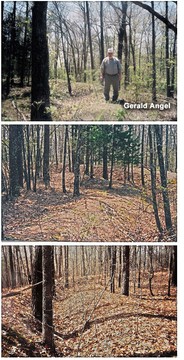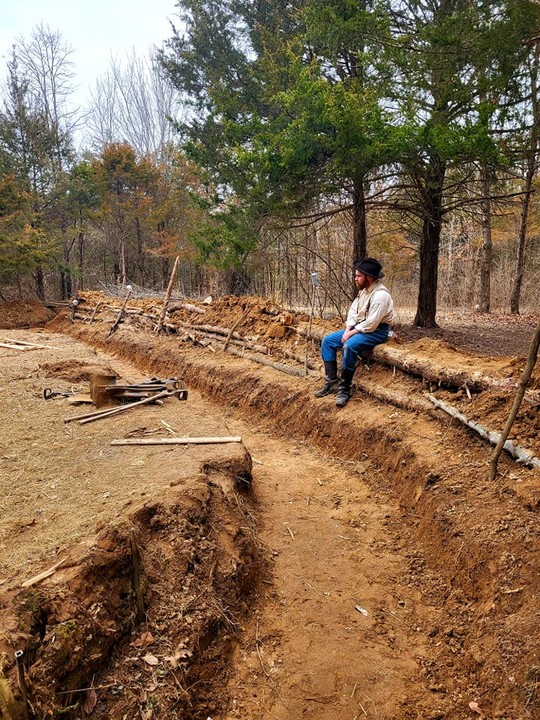Civil War Fortification at Barnesville (Fort Barnesville)
Introduction
Text-to-speech Audio
The historic fortification was constructed by the 13th Illinois Cavalry in early 1863 and was strategically located along a military trail between Pilot Knob and Van Buren, Missouri. The United States Army stationed its troops in nearby Barnesville and used the temporary fort which was known as a redoubt to help their troops defend the largely undeveloped, rugged area more known for its instability and guerrilla warfare than organized battles. The earthen remains of this fortification are one of the few surviving Civil War temporary field fortifications in the state
Images
Fort Barnesville, Missouri

Fort Barnesville, Missouri

Backstory and Context
Text-to-speech Audio
During the Civil War, the rugged and nearly desolate Ozark Highlands between St. Louis and northern Arkansas coupled with varying loyalties resulted in prolonged guerrilla warfare. Indeed, similar to twentieth-century Northern Ireland, the Civil War in southern Missouri consisted of neighbor fighting neighbor and organizing troops amidst a terrain abounding in hills, thick virgin forests, and deep river valleys proved daunting, to say the least. The majority of roads spanning the Ozark wilderness were little more than deer tracks and centuries-old Native American walking paths. The rugged routes took people through the woods, along river bottoms, or across towering hills. Most of the routes were only wide enough to support a single horse and rider. Thus, vicious raids supplanted typical nineteenth-century battle strategies in the Ozark Highlands.
Typically, small bands of guerrilla soldiers, acting more like raiding pirates, hid in the woods before launching surprise attacks on small scattered communities that dotted the region. The guerrillas usually sympathized with the Confederate cause. Once they successfully looted and destroyed a town, they would flee into the woods. The hit-and-run warfare made travel between the populated areas of eastern Missouri and the Arkansas River valley exceptionally dangerous and made it virtually impossible for Federal troops to control. Thus, a need arose for a strong Union military presence in the Ozarks to help win the war west of the Mississippi; the fort emerged as part of that need.
One primary road existed, allowing for horse and wagon transportation, The Belleview Trail, which became known as the Military Trail, connected St. Louis to Pilot Knob, and then down to Arkansas. The Federal troops selected a point along the important trail to construct the redoubt. After the troops cleared the area of its thick trees, the location of the redoubt offered a clear vista of the trail as it approached Barnesville from the south.
Although details about its true builders and the exact date of completion are difficult to ascertain, evidence points to the 13th Illinois Cavalry (Union) most likely building the fort during the winter and spring of 1862 into 1863. The 13th Illinois Cavalry assembled in Camp Douglas, Chicago, Illinois on October 30, 1861, moved to Benton Barracks, St. Louis, Missouri in February 1862, and then marched to Banreville in May 1862. The 2nd Battalion moved onward to Arkansas along with its 100 wagons full of provisions while the 1st Battalion remained in Missouri to scout the Military Trail; their knowledge of the trail would have been instrumental in the placement of the redoubt.
Various troop companies stayed at the fort, notably after a significant flood near a river forced troops to flee their camps. The 13th Illinois routinely left and returned the fort, encountering troops and guerrillas, burning towns, obtaining supplies, burning perceived rebel-friendly towns, and more. Though an organized force of 1,000 Confederate troops eventually made their way to the fort, they could not hold their position. By 1864, Union forces pushed the front south and east. Still, the Ozark Highlands remained home to an abundance of Confederate sympathizers, leaving the threat of raids as an ever-present danger.
The 1870 Federal Census noted 664 families in Reynolds County with 110 of them headed by widows. In fact, despite the war being over for five years, forty-six of the widows were still under the age of 40, which speaks to the war's heavy impact on the area. Unlike areas to Missouri's east, where historic battlefields are plenty, a simple redoubt remains as the county's only reminder of the unique warfare that existed in the Ozark Highlands, and the effect it had on those who lived here at the time.
Sources
Angel, Gerald and Alien Tatman. "Registration Form: Civil War Fortification at Barnesville." National Register of Historic Places. mostateparks.com. 1998. https://mostateparks.com/sites/mostateparks/files/Civil%20War%20Fortification%20at%20Barnesville.pdf.
Grasso, Christopher. "Fighting Guerrillas in Civil War Missouri." Yale University Press. yale.edu. June 5, 2017. https://yalebooks.yale.edu/2017/06/05/fighting-guerrillas-in-civil-war-missouri/.
Greene County Archives and Records Center. "State of Missouri vs. William J. Kelly - 1866." Community and Conflict: The Impact of the Civil War in the Ozarks. Accessed June 23, 2022. https://ozarkscivilwar.org/archives/3388.
Jasper County Records Center. "Lee P Gray vs. John B. Dale - 1865." Community and Conflict: The Impact of the Civil War in the Ozarks. Accessed June 23, 2022. https://ozarkscivilwar.org/archives/3520.
Jasper County Records Center. "Thomas R. Livingston Collection." Community and Conflict: The Impact of the Civil War in the Ozarks. Accessed June 23, 2022. https://ozarkscivilwar.org/archives/1140.
State Historical Society of Missouri Research Center - Columbia. "Ozias Ruark Collection." Community and Conflict: The Impact of the Civil War in the Ozarks. Accessed June 23, 2022. https://ozarkscivilwar.org/archives/1265.
http://www.rcghs.org/fort-barnesville/
https://www.facebook.com/groups/478723536557612
